In Colonial times, sassafras (
Sassafras albidum) was a significant export crop from North America. It was valued for the medicinal and culinary properties of its leaves, bark and roots, and for its strong, lightweight wood. Sassafras bark and roots were key flavor components in root beer.
Although its economic value isn’t as high as it was 400 years ago, sassafras is appreciated today for its beautiful fall foliage and usefulness to wildlife, as a larval host for butterflies and provider of berries for birds. It grows naturally as a thicket, producing multiple root sprouts as it spreads. Growing this way, it’s an excellent choice for a hedgerow or woodland border. It also can be used as a specimen tree in a lawn, where its upright form and relatively open canopy make it easy to maintain grass around it.
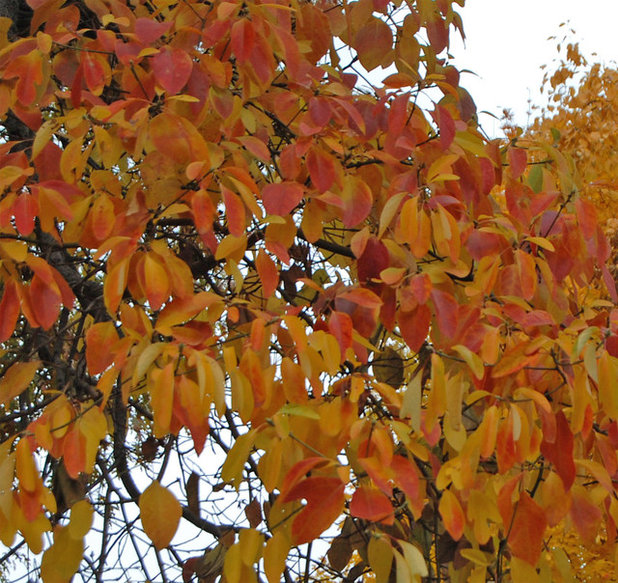 Botanical name: Sassafras albidumCommon names:
Botanical name: Sassafras albidumCommon names: Sassafras, white sassafras, ague tree, cinnamon wood, mitten tree, saloop, smelling stick
Origin: Native from Maine south to Florida, and west as far as Texas and Iowa
Where it will grow: Hardy to minus 30 degrees Fahrenheit, or minus 34 degrees Celsius (USDA zones 4 to 9; find your zone)
Typical plant communities: Sassafras grows best in open woods on moist, well-drained, sandy loam soils. It grows as a pioneer species on abandoned fields, along fence rows, and on dry ridges and upper slopes.
Water requirement: It prefers moist soils but grows well on sites with average moisture levels.
Light requirement: Full sun but tolerates light shade; suppressed growth in shadier sites
Shown: This photo shows the range of fall colors typical of sassafras.
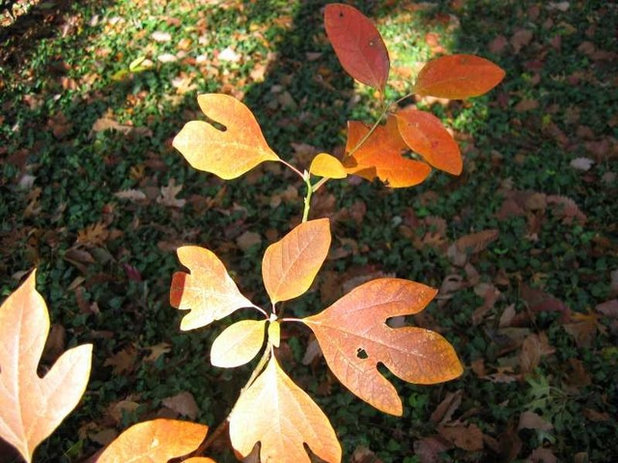 Mature size:
Mature size: 30 to 60 feet tall and 25 to 40 feet wide
Benefits and tolerances: Tolerates a wide variety of soils; drought-tolerant once established; somewhat deer-resistant
Seasonal interest: Sassafras has showy fall foliage. Small greenish-yellow flowers appear in midspring, just as leaves begin to unfurl. Dark blue fruits, about half an inch across, are a big hit with wildlife at the end of summer.
When to plant: Balled-and-burlapped trees should be planted in the early spring and can be slow to establish. Container-grown plants are more forgiving and generally preferred. If growing from seed, provide 60 to 90 days of cold, moist conditioning to get good rates of germination.
Although sassafras isn’t common in the nursery trade, some commercial nurseries do carry these trees, and nurseries carrying native species are more likely to have them.
Shown: Leaves may be entire (no lobes), or divided into two or three lobes.
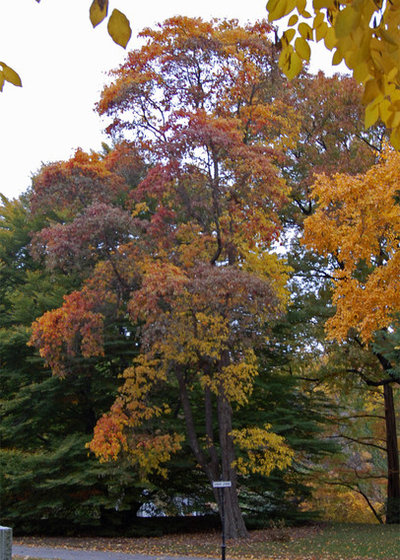 Distinguishing traits.
Distinguishing traits. This medium-size tree has an upright form with a strong central trunk and short lateral branching. This gives the foliage a layered, cloud-like form. Sassafras has a large taproot with wide-spreading heavy lateral roots. These make successful transplanting of field-grown trees difficult. The fruit is a dark blue drupe on a red pedicel (stem) and ripens from August to September. All parts of the tree have an aromatic scent. When bruised, the leaves have a scent of vanilla and orange.
A helpful identifying feature of sassafras is the three types of leaves randomly arranged on each branch. Each leaf may have zero, two or three lobes, or protrusions. The two-lobed form looks like a child’s mitten.
Sassafras is dioecious, which means that male and female flowers occur on separate plants. The pale yellow flowers appear in midspring, with the blooms on male trees being a bit showier due to the protruding stamen.
Shown: A mature sassafras tree at the Mount Auburn Cemetery in Cambridge, Massachusetts, shows how the foliage grows in cloud-like layers.
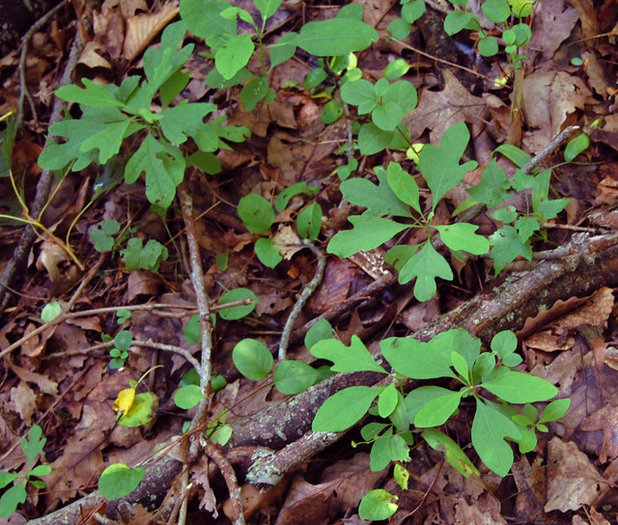 How to use it
How to use it. Sassafras can be used naturalistically as a clonal shrub or small tree in hedgerows and woodland edges, or maintained as a single-trunk specimen or lawn tree in more formal settings.
For many years, sassafras was used as an herbal treatment and as a flavoring agent. Studies conducted in the 1960s showed some of its components to be toxic or carcinogenic, but it was later determined that toxic components were associated with the oil of sassafras. Seasonings with the oil removed are now allowed. The leaves have very low levels of the toxic oil and are used to make filé powder, an ingredient in gumbo.
Shown: These sassafras root sprouts, a common sight in many woodlands, indicate that a larger tree is nearby.
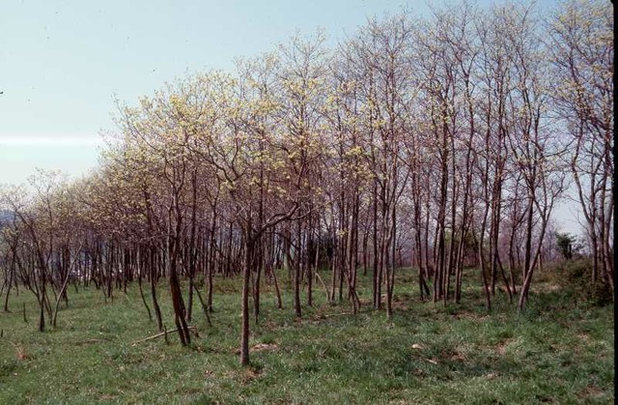 Planting notes.
Planting notes. These trees are difficult to transplant, so initial placement should be carefully considered. They grow moderately fast, reaching fruiting size in about 10 years. The typical lifetime for a well-placed sassafras tree is 50 to 75 years. The preferred soil pH is 6 to 7. Plants in alkaline soils often suffer from iron chlorosis.
Sassafras has a strong tendency to produce root sprouts some distance from the parent tree. These should be removed if you want a single-trunk specimen tree, but allowing them to grow and form a thicket is more effective in a naturalistic setting. Sassafras can be propagated from sprouted root cuttings. If you try this, take the cuttings in early spring as far out from the parent plant as possible to minimize disruption of the root system.
Both male and female plants are needed for fruit production. If you don’t have these already growing nearby, consider planting three to five trees to help ensure that you have at least one of each sex. Note that if you’re using root cuttings from the same plant, they’ll be of the same gender.
The roots and leaves contain substances that inhibit the germination of many other plants. This effect is more pronounced in large sassafras groves than for a single tree. Annual and biennial species don’t grow well near these trees, while running and vining species, such as Virginia strawberry (
Fragaria virginiana) and Virginia creeper (
Parthenocissus quinquefolia), grow well. Cleaning up the leaf litter under the tree decreases this inhibitory effect.
Shown: A thicket of sassafras grows into an old field habitat. For a week or two in the spring, the flowers create this hazy yellow effect.
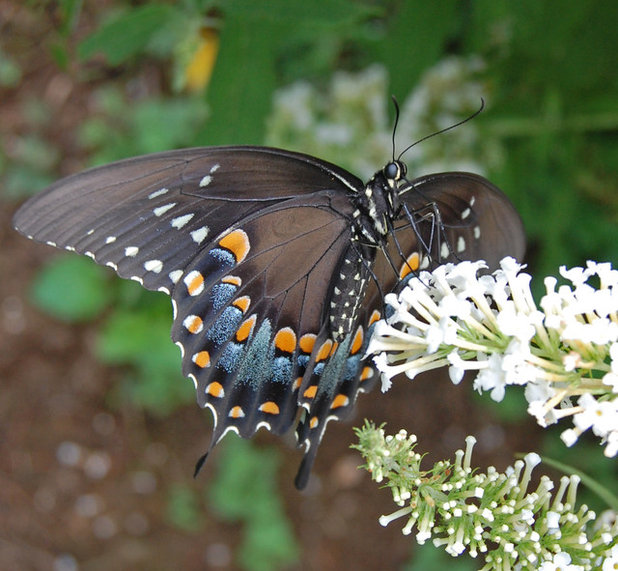 Wildlife notes.
Wildlife notes. The midspring flowers are pollinated by small bees and some species of flies, which are attracted to the nectar in both male and female flowers. Some bees collect the pollen to feed to their larvae.
Sassafras is a host plant for several species of swallowtail butterflies, most notably the spicebush swallowtail (
Papilio troilus), and several moths, such as the Promethea and Io moths.
Many songbirds feed on the fruits. The birds eat the entire fruit and expel the seed some distance from the parent plant. Deer will browse on the twigs and foliage, but sassafras doesn’t seem to be a favorite for them.
Shown: This spicebush swallowtail is one of the species of butterflies whose larvae feed on the leaves of the sassafras tree.





